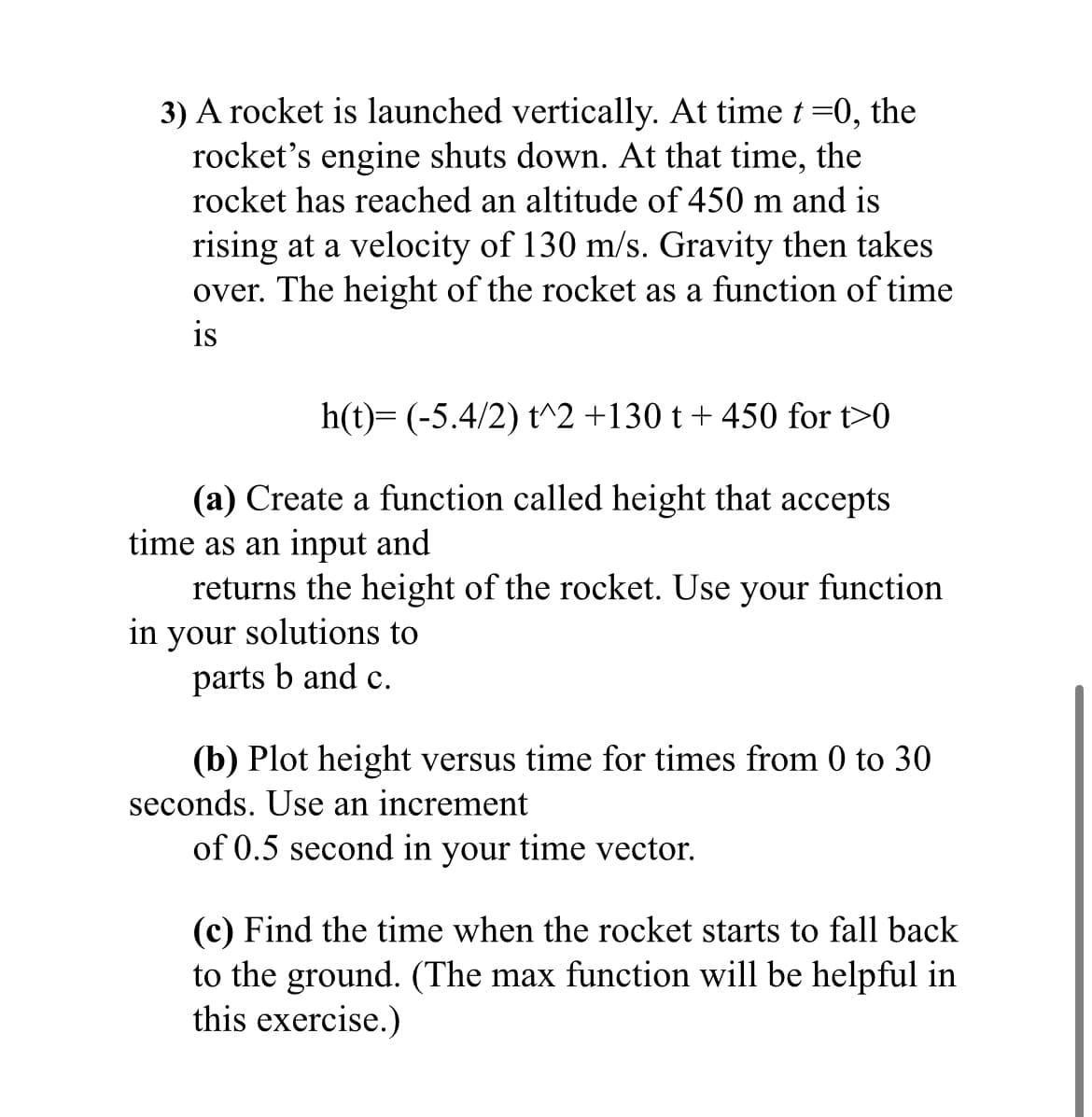3) A rocket is launched vertically. At time t=0, the rocket's engine shuts down. At that time, the rocket has reached an altitude of 450 m and is rising at a velocity of 130 m/s. Gravity then takes over. The height of the rocket as a function of time is h(t)= (-5.4/2) t^2 +130 t + 450 for t>0 (a) Create a function called height that accepts time as an input and in returns the height of the rocket. Use your function your solutions to parts b and c. (b) Plot height versus time for times from 0 to 30 seconds. Use an increment of 0.5 second in your time vector. (c) Find the time when the rocket starts to fall back to the ground. (The max function will be helpful in this exercise.)
3) A rocket is launched vertically. At time t=0, the rocket's engine shuts down. At that time, the rocket has reached an altitude of 450 m and is rising at a velocity of 130 m/s. Gravity then takes over. The height of the rocket as a function of time is h(t)= (-5.4/2) t^2 +130 t + 450 for t>0 (a) Create a function called height that accepts time as an input and in returns the height of the rocket. Use your function your solutions to parts b and c. (b) Plot height versus time for times from 0 to 30 seconds. Use an increment of 0.5 second in your time vector. (c) Find the time when the rocket starts to fall back to the ground. (The max function will be helpful in this exercise.)
Elements Of Electromagnetics
7th Edition
ISBN:9780190698614
Author:Sadiku, Matthew N. O.
Publisher:Sadiku, Matthew N. O.
ChapterMA: Math Assessment
Section: Chapter Questions
Problem 1.1MA
Related questions
Question
Help me solve this USING MATLAB

Transcribed Image Text:3) A rocket is launched vertically. At time t=0, the
rocket's engine shuts down. At that time, the
rocket has reached an altitude of 450 m and is
rising at a velocity of 130 m/s. Gravity then takes
over. The height of the rocket as a function of time
is
h(t)= (-5.4/2) t^2 +130 t + 450 for t>0
(a) Create a function called height that accepts
time as an input and
returns the height of the rocket. Use your function
in your solutions to
parts b and c.
(b) Plot height versus time for times from 0 to 30
seconds. Use an increment
of 0.5 second in your time vector.
(c) Find the time when the rocket starts to fall back
to the ground. (The max function will be helpful in
this exercise.)
Expert Solution
This question has been solved!
Explore an expertly crafted, step-by-step solution for a thorough understanding of key concepts.
This is a popular solution!
Trending now
This is a popular solution!
Step by step
Solved in 4 steps with 1 images

Knowledge Booster
Learn more about
Need a deep-dive on the concept behind this application? Look no further. Learn more about this topic, mechanical-engineering and related others by exploring similar questions and additional content below.Recommended textbooks for you

Elements Of Electromagnetics
Mechanical Engineering
ISBN:
9780190698614
Author:
Sadiku, Matthew N. O.
Publisher:
Oxford University Press

Mechanics of Materials (10th Edition)
Mechanical Engineering
ISBN:
9780134319650
Author:
Russell C. Hibbeler
Publisher:
PEARSON

Thermodynamics: An Engineering Approach
Mechanical Engineering
ISBN:
9781259822674
Author:
Yunus A. Cengel Dr., Michael A. Boles
Publisher:
McGraw-Hill Education

Elements Of Electromagnetics
Mechanical Engineering
ISBN:
9780190698614
Author:
Sadiku, Matthew N. O.
Publisher:
Oxford University Press

Mechanics of Materials (10th Edition)
Mechanical Engineering
ISBN:
9780134319650
Author:
Russell C. Hibbeler
Publisher:
PEARSON

Thermodynamics: An Engineering Approach
Mechanical Engineering
ISBN:
9781259822674
Author:
Yunus A. Cengel Dr., Michael A. Boles
Publisher:
McGraw-Hill Education

Control Systems Engineering
Mechanical Engineering
ISBN:
9781118170519
Author:
Norman S. Nise
Publisher:
WILEY

Mechanics of Materials (MindTap Course List)
Mechanical Engineering
ISBN:
9781337093347
Author:
Barry J. Goodno, James M. Gere
Publisher:
Cengage Learning

Engineering Mechanics: Statics
Mechanical Engineering
ISBN:
9781118807330
Author:
James L. Meriam, L. G. Kraige, J. N. Bolton
Publisher:
WILEY